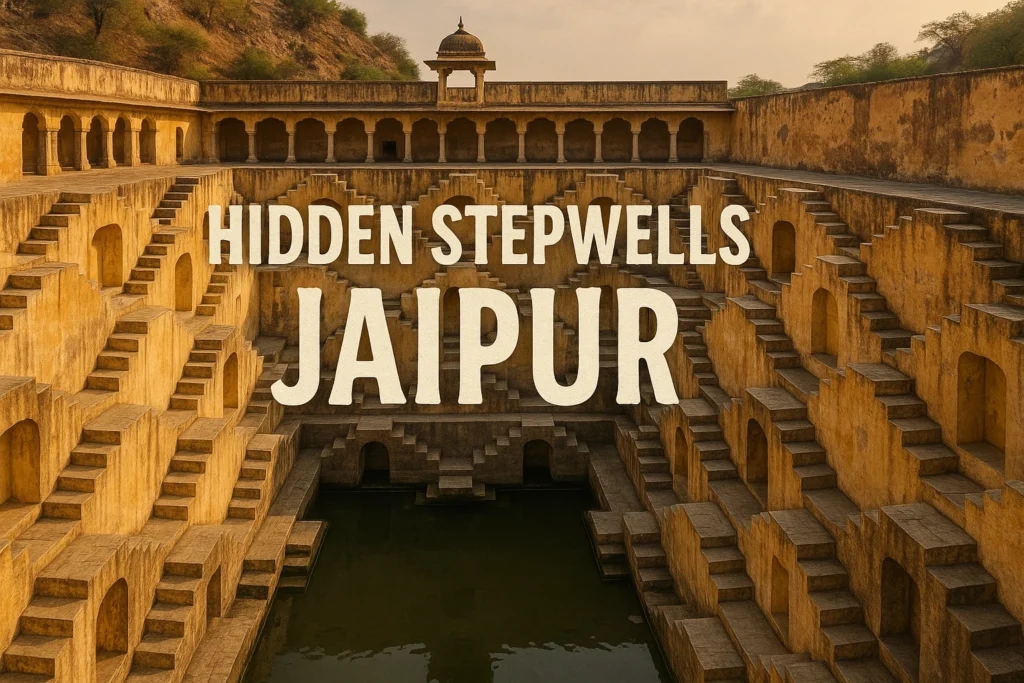
Hidden Stepwells of Jaipur
Table of Contents
Jaipur is famous for its grand palaces, massive forts, and colorful markets. But hidden behind the busy streets and popular landmarks lies a quiet and mysterious world — the world of ancient stepwells, also known as baoris.
These stepwells were once an important part of daily life in Rajasthan. Built to collect and store rainwater, they also served as places for rest, social gatherings, and even prayer. While some, like Panna Meena Ka Kund, are known to a few travelers, many others remain completely hidden — unknown even to most locals.
In this blog we wll discover hidden stepwells of Jaipur — peaceful, historical, and rich in architecture.
What Are Stepwells (Baoris)?
Stepwells are ancient underground structures built to store water and allow easy access to it during all seasons. In Rajasthan’s dry climate, these baoris were vital to survival, and beautifully crafted to serve both practical and spiritual needs.
Read My Latest Blog :- Teej Festival in Jaipur
Why Are These Stepwells Hidden Today?
Though they were once central to life, many stepwells have now become hidden due to:
Urban development around them
Lack of signage or tourism promotion
Location in quiet, remote areas
Architectural Highlights of Stepwells
Symmetrical staircases that create optical illusions
Made from local sandstone and lime
Multiple entry points from different directions
Built to last centuries, even underground
Cultural Significance of Stepwells
Baoris were more than just wells. They were where women gathered, kids played, and festivals began. During Gangaur or Teej, the community came alive around them. Even today, some baoris are seen as sacred.
Check Why tourist hire local guide in Jaipur
1. Nahargarh Stepwell – Hidden Inside the Fort
Most tourists visit Nahargarh Fort for city views, but few know about the stepwell tucked within its walls. With perfect symmetry and centuries of history, this hidden baori offers both silence and beauty.
Style: Multi-layered stone steps
Best Time: Early morning or late afternoon
Why It’s Special: No crowds, perfect photography spot
2. Amer Baori – Still Alive With Water
Behind the Amber Fort lies a working stepwell that locals still use. It’s rustic and functional — a rare sight in a royal city.
Experience: Authentic, untouched
Tip: Don’t go alone — the path is easy to miss
Story: I often tell visitors how this baori kept the royal kitchens running centuries ago
3. Kanak Vrindavan Baori – Hidden Beside Temples
Tucked away near the temple gardens of Kanak Vrindavan, this baori once played a role in religious rituals. It’s calm, green, and full of energy.
Why Visit: Peaceful spiritual site
Pro Tip: Pair with morning temple visit
What I Show: How it’s aligned with Krishna temples nearby
4. Brahmpuri Baori – A Sacred Secret
In one of Jaipur’s oldest neighborhoods, this baori sits quietly behind temples and homes. Most people don’t know it exists — even locals.
History: Linked to ancient temple rituals
Who Should Visit: Explorers, spiritual travelers
Tip from Me: Go only with someone who knows the lanes — it’s a hidden maze
5. Panna Meena Ka Kund – Beautiful but Misunderstood
Many know this baori because of Instagram, but very few know its stories. Located near Amber Fort, this stepwell is a masterpiece of symmetry and legend.
Known For: Perfect zigzag design
Story: Locals believe no one can climb down and up using the same set of stairs
What I Do: Show you the exact angle for the perfect photo — without the crowd
Why You Should Visit with Dhanraj Tour Guide (That’s Me)
I’ve lived in Jaipur all my life — I know the real stories
These baoris are not on Google Maps
Some are in isolated areas — local guidance ensures safety
Conclusion: Walk the Steps of Forgotten History
These stepwells are more than stones — they are stories, culture, engineering, and spirituality combined. Most tourists never get to see them. But you can.
📞 Want to Explore Hidden Jaipur?
Contant us